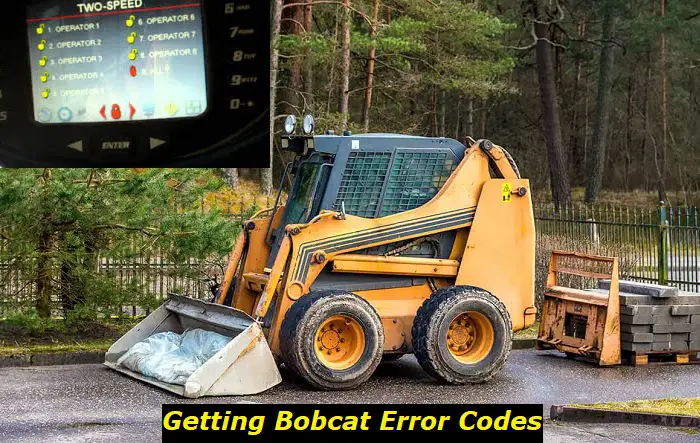How to Get Bobcat Error Codes: Understanding and Fixing Them
When operating heavy machinery like Bobcat equipment, encountering error codes is inevitable. These codes are designed to signal any issues that need attention, thus it's essential for operators and mechanics to understand them to ensure smooth operations. This article aims to create a comprehensive guide on how to get Bobcat error codes, providing a useful resource for anyone who operates or deals with such equipment.
Further, we will delve into the basics of these error codes, shedding light on their significance, how you can retrieve them, and what they mean. Additionally, we will explore common troubleshooting steps to address these errors, a vital knowledge set for effectively running Bobcat machinery. Stay with us in this article to unlock the mastery over your Bobcat error codes and keep your machinery in prime condition.

Understanding the Basics of Bobcat Error Codes
When it comes to operating Bobcat heavy machinery, the intelligent systems embedded in the equipment perform just as significant a role as the mechanical aspect. One essential function of these systems is the production and display of error codes or fault codes. To manage your Bobcat equipment effectively, you must have an underlying understanding of these Bobcat Error Codes.
So, what are they exactly? Error Codes are essentially the machine's way of communicating problems or misalignments happening within the system. Think of them as the Bobcat's language, a way for it to 'speak' about the issues it encounters during its operations. The machine generates these codes when it identifies anything out of the ordinary within the system. They cover a wide range of problems, from hydraulic or engine issues to electrical faults.
The Bobcat Error Codes are displayed on your machine's instrument panel, precisely to ensure visibility to the operator. Understanding these codes' meanings will not just save time when issues arise, but also helps prevent future, potentially more severe problems which could lead to expensive repair or even machinery replacement.
However, it's equally essential to remember that not all displayed codes necessarily mean a severe problem. Error codes range from simple operator errors such as leaving the safety belt unbuckled to severe engine malfunctions.
In the end, comprehending these Bobcat Error Codes aids in diagnosing machinery issues early, which is the key to maintaining the health and performance of your Bobcat heavy machinery.
Practical Steps to Retrieve Bobcat Error Codes
When working with Bobcat machinery, it's crucial to comprehend the process of retrieving error codes. These codes are instrumental in guiding you to identify potential issues and apply the appropriate remedial measures. Here are the practical steps that will lead you effortlessly to grab those insightful Bobcat error codes.
First off, it is necessary to locate the display panel in your Bobcat machine, typically found on the computer panel. The error codes will crop up here whenever a problem transpires within the system. To pull out the error codes, simply turn on your Bobcat equipment, and closely monitor the display panel. Any codes that appear are considered 'Active' and indicate real-time issues that need immediate attention.
Those codes won't always stick around, which brings us to the importance of understanding how to access 'Stored' error codes. These are codes for issues that occurred in the past but aren't currently active. To access these, navigate through the machine's menu (often through the info or diagnostics button) until you reach the 'stored codes' section.
Upon spotting the error code, jot it down. They typically have a letter followed by four numbers. While the letter is often indicative of the specific category of the issue, the numbers often point towards the specific problem itself. In most situations, you might find multiple codes stored. In such instances, interpret them from the highest to the lowest.
Now, what about instances when your machines are not equipped with this digital means of diagnosing issues? Old school it is! Many Bobcat machines still rely on LED lights flashing in specific patterns to represent error codes. In such cases, look out for the patterns created by flashing lights on your control panel. A service manual will be exceedingly useful to decipher these 'flash' codes.
The last part sweeps in with the interpretation of these error codes. Remember, each error code refers to a particular problem, be it a malfunctioning part or a general system error. With your list of error codes, you can then refer to the Bobcat service manual or technician handbook to understand what each of these codes represents and plan your repairing strategy accordingly.
Retrieving Bobcat error codes is a skill as fundamental as driving the machine itself. With a little patience and practice, it becomes second nature, enabling you to perform routine diagnostics, troubleshoot and conduct repairs like a true professional.
Common Bobcat Error Codes and Their Meanings
The Bobcat machinery utilizes a systematic network of codes to keep you notified about its various operational aspects. Every code indicates a different area of concern, making it essential for operators and mechanics to have a clear understanding of these codes. Here we dive into some common Bobcat error codes that you might encounter on the job.
Error Code 01-18: Engine Speed Sensor. This code implies that there may be a problem with the engine speed sensor. The sensor may be malfunctioning, causing inaccurate readings of engine speed. This could tamper with the smooth running of the Bobcat machinery.
Error Code 02-15: Controller Lockout Relay Coil. This code signifies a problem with the controller lockout relay coil. A fail-safe device, the relay coil's function is to protect the machinery from sudden power overloads. If there's an issue with the coil, the machine won't run at its optimal performance.
Error Code 22-02: Right Handle Start Switch. When this code shows up, it's an indication that there's an issue with the right handle start switch. This problem could interfere with the overall control of the machine.
Error Code 34-04: Deliberate Ignition Switch Manipulation. This error code refers to a deliberate manipulation of the ignition switch. Essentially, it indicates that the machine's security might have been compromised.
Error Code 61-04: Brake Release Signal. This code is indicative of a problem with the brake release signal. The Bobcat machine may experience difficulties in moving forward or backward due to issues in releasing the brake.
Understanding these common error codes is your first step in ensuring a smooth operation of the Bobcat equipment. With this knowledge, you can promptly address the issues that these error codes signify, leading to a more efficient operation of the machinery. So remember, an error code is not a nuisance, but help at hand!
Troubleshooting and Fixing Standard Bobcat Errors
Smooth operation and efficiency of your Bobcat equipment are crucial for every job you undertake. It eases your day-to-day tasks, maximizes productivity, and elongates your machinery's life. Thus, knowing how to troubleshoot and fix standard Bobcat errors becomes an indispensable skill.
Let's start with a commonly seen Bobcat error code, ACU 523266-4. This fault code indicates an issue with the Auxiliary controller, and it comes up when there's a failure in one of the driver circuits. When you see this error, you should check for broken wires or loose connections in the controller.
In contrast, another frequently encountered error code is ACU 523051-2, signaling a switch error in the foot switch. In this case, inspect your foot switch and ensure it's free from debris and properly connected.
Now, take the error code ENG 128s254 04, it means there's an open circuit on the engine coolant sensor. If this pops up on your panel, a complete check of the sensor's circuit and the coolant's level and condition is required. A potential fix could be as simple as cleaning the sensor, topping up the coolant level or replacing a worn-out sensor.
The proficiency in troubleshooting becomes crucial when you see an error code like HYD 057 16. This indicates the hydraulic charging system is experiencing high pressure. It's essential to check all hydraulic connections, seals, and lines to make sure there are no leaks or blockages.
Take note, these techniques are examples on how to troubleshoot standard Bobcat errors, but it's important to always refer to your Bobcat's operation and maintenance manual for specific instructions regarding your model. And remember, whenever you feel uncertain, don't hesitate to seek professional advice or assistance.

Add comment